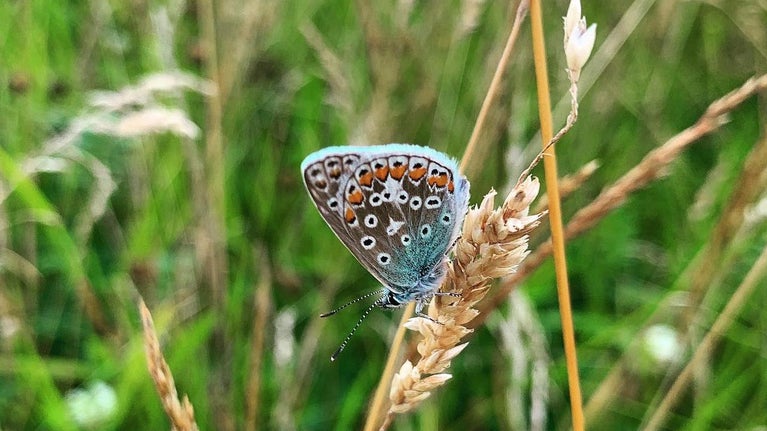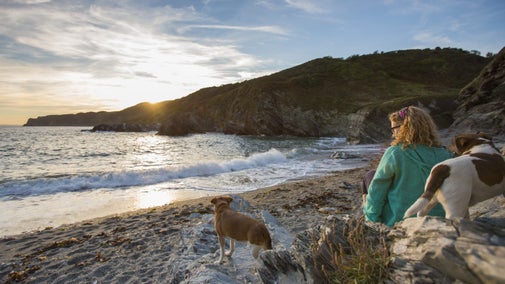
Discover more at the Whitehaven Coast
Find out how to get to the Whitehaven Coast, where to park, the things to see and do and more.

Only 5½ miles from the border of the Lake District National Park, the Whitehaven Coast stretches south from the 18th-century harbour of Whitehaven towards the sandstone cliffs of St Bees Head. From carpets of colourful wildflowers to thousands of nesting seabirds, there's lots to discover when exploring this part of the world.
Winter walking on the Whitehaven Coast can be literally breath taking, it's easy to park, easy to walk and, as long as you're wrapped up warm, will certainly blow away the cobwebs.
Leaning into the wind and watching plumes of white spray as granite-grey seas pound into the sandstone harbour wall is one of the most exhilarating sights on the Whitehaven Coast in winter.
St Bees head, just 3½ miles south of Whitehaven harbour, is the most westerly point in northern England, with the tallest sea cliffs in north-west England, and views to the Isle of Man and the mountains of southern Scotland.
Winter brings exceptional clarity to the air and when the Scottish mountains are capped with snow, they seem to stretch never-endingly to the horizon.
Met Office records show that the Isle of Man and the Cumbrian coast are among the most exposed parts in England because of their proximity to the Atlantic. From December to February, the frequency and ferocity of the storms is at its greatest. Wind speeds of over 70mph have been recorded on the coast, with the record being held by St Bees where 88mph gusts were recorded in 2005.
Whitehaven’s West Pier feels the brunt of the storms, in 2014 waves ripped off railings and stonework, eroding spoil from the Wellington pit and throwing it over the sea wall in great muddy splurges.
In contrast to all this ‘sturm und drang’ when we do get a still day, the early sunsets in the months around the midwinter solstice mean that you can spend time watching the light unfold in the clouds, and still get home in time for dinner.
In December, sunset is around 3:45pm, by the end of January it’s 4:45pm and by the end of February 5:45pm.

If you park at the free car park beside Haig Pit (CA28 9BG) and walk along the level pathways towards the harbour, you’ll find plenty of benches where you can stop, break out the thermos flask and watch as the colours flood the clouds overhead and the sea below.
Parking at Tarn Flatt Hall farm on St Bees head (honesty box for the famer), is the start of a 1½ mile walk past the lighthouse and down to the hidden shingle beach of Fleswick Bay, or you can walk the 4½ miles from the car park at Haig Pit (CA28 9BG).
It’s quite a scramble down to the beach from the clifftop path, so walking boots, a headtorch and warm clothes are definitely recommended, but it’s worth it for the depth of the colour as the sun sets fire to the red sandstone cliffs.
If you leave the beach just after sunset, then you can have the extra magical moment of seeing the lighthouse lamp shine for the first time that night as you pass it on the way back to the car.
Every autumn, between 3,000 and 10,000 bulbs are lovingly tucked into the soil around the entry and exit points to the clifftop site, so that, come spring, there is a riot of early colour to greet you.
The show begins in January and February with snowdrops, followed by crocuses and dwarf irises. Then, from March through to June, you'll see daffodils, Chionodoxa, Ornithogalum, Ixia, Anemone, fritillaries, hyacinths, tulips, bluebells, alliums, chives and Eremurus.
- Chris, Whitehaven Coast Ranger
Alongside the planted bulbs, wildflowers flourish on the old mining sites. On the Haig Colliery site, there's a pretty show of wildflowers to enjoy. Yellow primroses, cowslips and coltsfoot come in February and March, heralding the arrival of spring.
In April, the fritillaries are out, amazing visitors with their chequerboard-pattern flowers. By June, kidney vetch and bee orchid are among favourites to spot. August brings red bartsia and heather, along with many other fine blooms such as grass vetchling, a delicate pink flower that's a local rarity.
If you look closely, you’ll see bird's foot trefoil, hairy tare, black medic, and red and white clover, all of which fix nitrogen from the air to enrich the ground. Can you find the elusive scarlet pimpernel?
The most reliable animals to spot when you’re taking a walk along the Whitehaven Coast are the seabirds that can be spotted from the harbour to the cliffs.
In the harbour, see the barnacle geese and swans that over-winter here. You'll probably hear the colony of jackdaws on Wellington Terrace, especially in spring as they make nests in the drainage holes in Wellington Pit’s old walls.
Thousands of nesting birds inhabit the Whitehaven Coast, including England’s only breeding colony of black guillemots.
At the Candlestick, train the available telescope onto South Shore and try to spot the red shanks, oystercatchers and cormorants resting on Tom Hurd’s Rock. If you head up to the meadow areas on the clifftops, you'll be able to see starlings and herring gulls regularly feeding. If you're lucky, you may even see a grey partridge or a goldfinch.
The old mine buildings provide homes for kestrels and barn owls, which you might just see hunting around the clifftops. And during the summer, watch the swallows swoop and skim the meadows for food.

Look out for the common lizard on the Wagon Way walls, and slow-worms in the scrubby grassland next to Solway Road. Common blue butterflies can be found around Haig and on the cliff edges, wherever there are trefoils growing. And if you look out for creeping thistles, you can often spot orange soldier beetles hanging out, as well as creatures such as peacock butterflies and aphids.

Find out how to get to the Whitehaven Coast, where to park, the things to see and do and more.
Discover the 890 miles of beautiful coastline in our care. Plan your next coastal adventure, whether you want to explore soft, sandy beaches or rugged, windswept cliffs.

While canoeing and kayaking are great ways to experience nature and keep fit, they can be dangerous if you don't follow the guidelines. Learn how to stay safe with our advice and guidance.

Try out the ‘50 things to do before you’re 11¾’ activities children can enjoy by the sea, from paddling or swimming, to catching crabs and skimming stones.

The Whitehaven Coast offers more than just sea views and a colourful coast: discover an under-sea coalmine, fog horn station and eighteenth-century harbour.

Plan an adventure this summer with our activity guides for children. Try everything from floating in a boat, to rock-pooling, identifying animal poo and fossil hunting.

Discover some of the best coastal spots and beaches to explore in the Lake District.
